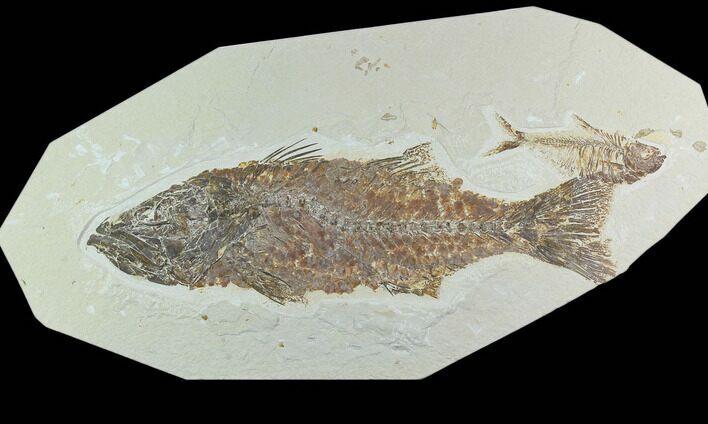This Specimen has been sold.
13.7" Mioplosus With Diplomystus - Wyoming
This is two fossil fish from the Green River Formation near Kemmerer, Wyoming. The larger is a 13.7" Mioplosus, one of the more uncommon species from the formation. The smaller is a 4.8" Diplomystus, one of the most common. This specimen shows bones, fin rays and scales. This specimen has been stabilized with adhesive to protect the fossils. The cluster of dark spots near the top of the specimen are coprolites, fossilized fish feces.
It comes with an acrylic display stand.
It comes with an acrylic display stand.
Mioplosus is a genus of large extinct perciform fish that lived through the Eocene epoch. This genus is easily distinguished by an elongate fusiform body, double dorsal fins, and forked tail. Mioplosus was a solitary predator with large teeth: a few fossil specimens have been collected with other, smaller fish lodged in their throats. Most fossils of this genus are from the Tertiary-aged Green River Formation in Wyoming, though relatives of this genus are known to range throughout Asia and New Zealand. Mioplosus is also believed to be related to the modern pike-perch of the genus Sander (Stizostedion).
About Knightia
Knightia is an extinct genus of small, schooling, ray-finned fish related to modern herrings and sardines. Abundant in the warm freshwater lakes of the Eocene Green River Formation, they fed on insects, plankton, and tiny fish, while serving as prey for nearly every larger predator in the ecosystem. The most common species, Knightia eocena, reached about 15 cm in length and is celebrated today as the state fossil of Wyoming.
These streamlined fish are recognized by their heavy scales, small conical teeth, and rows of dorsal and ventral scutes along the body. Their fossils are among the most iconic from the Green River Formation—an exceptional 48-million-year-old lake deposit in Wyoming, Colorado, and Utah known for preserving a remarkably detailed snapshot of ancient life in a warm, lake-rich Eocene landscape.
Knightia is an extinct genus of small, schooling, ray-finned fish related to modern herrings and sardines. Abundant in the warm freshwater lakes of the Eocene Green River Formation, they fed on insects, plankton, and tiny fish, while serving as prey for nearly every larger predator in the ecosystem. The most common species, Knightia eocena, reached about 15 cm in length and is celebrated today as the state fossil of Wyoming.
These streamlined fish are recognized by their heavy scales, small conical teeth, and rows of dorsal and ventral scutes along the body. Their fossils are among the most iconic from the Green River Formation—an exceptional 48-million-year-old lake deposit in Wyoming, Colorado, and Utah known for preserving a remarkably detailed snapshot of ancient life in a warm, lake-rich Eocene landscape.
SPECIES
Mioplosus labracoides, Diplomystus dentatus
LOCATION
Kemmerer, Wyoming
FORMATION
Green River Formation
SIZE
13.7" mioplosus, 4.8" diplomystus, 18.9 x 9.3" shale
CATEGORY
SUB CATEGORY
ITEM
#122666
We guarantee the authenticity of all of our specimens.
 Reviews
Reviews














